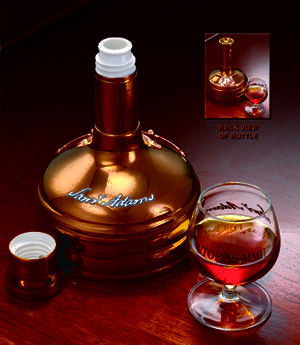Arriving at my house, after haranguing the post office into delivering it to me, I took note of what BrewDog had sent me. A plain box from their Tokyo beer style housed the precious bottle. It was encased in 12 feet of bubble-wrap, and neatly wrapped in brown paper. Someone had even taken the effort to hand-write "41%" on the paper in sharpie, I guess to remind you why you went through all the trouble to purchase this. As a shipping industry insider, I took a peek at what they had listed the beer as for customs purposes. "Yeast Samples for Analysis." Well, I guess I was about to "analyze" something...

(Seriously? A sharpie? This bow is a nice touch, however.)
Unwrapping the bottle, I discovered something rather plain. The bottle was mostly non-descript, and reminiscent of their other varieties of beer. If you saw it on a shelf somewhere, you would more than likely over-look it, unaware of what's actually in there. In all honesty, after over a month of waiting, I had expected some sort of fanfare. Perhaps a choir of angels singing the beers praise as I took up the bottle. I guess, in reality, all a bottle of beer can do is sit there until you drink it.

(It doesn't hover or anything...)
Since the bottle contains something with the same alcohol content as a bottle of whiskey, I invited a friend over to help me sample to goodness. With a simple pop of the top, and a light pour, we were off. We initially marveled at the carbonation of the beer (with the high alcohol content, how could bottle conditioning yeast survive?), and the fact that it briefly maintained a head (about 1/2 an inch). Dark golden brown/red in color, the beer had a very pungent bitter hop, alcohol (duh), and sour fruit aroma. Maybe a little spice? Forgetting to waft (like I was taught in high school chemistry), the first sniff of the beer was almost enough to knock me on my ass.
At $127 per 330ml bottle (after tax, shipping and conversion to US$), this needed to be one hell of a beer... and it certainly was. The first sip took my breath away, literally. The first thing you taste is the back end of the hop (like an uber version of Green Flash). The flavor was very reminiscent of the time I tasted a raw hop pellet. There was not much of the fruity/floral hop character to the flavor, mostly relying almost entirely on the hop itself (it was postulated that they probably use American hops). As I swallowed the first sip two things occurred. First, almost all of the moisture in my mouth disappeared; the beer had an extremely dry finish. Second, the beer gave me a very comfortable warm feeling, much like a whiskey, in the center of my chest. Overall, the flavor reminded me of a sour apple mash, with a heavy resinous hop flavor and a little hint of dark chocolate and caramel up top.
It's not easy to compare this beer to another. The most direct comparison I could make was to 26% ABV Sam Adams Utopias (When you talk about beers with this much alcohol content, there are very few to compare to). A few years back at the Great American Beer Festival, I was able to get about 6oz of the mythical Utopias, and enjoyed what I tasted. Compared to StB, Utopias was much thicker (almost viscous), sweeter (very strong dried fruit taste with honey and caramel), and lacked the carbonation present in the Scottish offering. However, by the very nature of the brewing process, Utopias is in a different league than StB. Utopias is brewed using traditional brewing methods, and StB gets around the limitations of those methods through a process where they freeze the batch and pour off the un-frozen (and more alcoholic) excess four times.

(Utopias is famous as much for the process as it is the result)
The only conclusion we could make was that BrewDog had accomplished something remarkable. While we mostly figured that it couldn't really be called a "beer" per se, the ingenuity required to push the boundaries into the unknown was plain to see. You certainly wouldn't want to drink too much of this in one sitting, but everyone who tried it was impressed both by the engineering and the result. To be brutally honest, I was expecting something awful and undrinkable; that the brewers would've been too caught up in the process and forgotten the result. But, the "beer" was not only drinkable, it was kind of good! An impressive effort all around. You don't get to try something like this every day, and I was happy to have taken the shot in the dark to taste it.
Happy Friday!

No comments:
Post a Comment